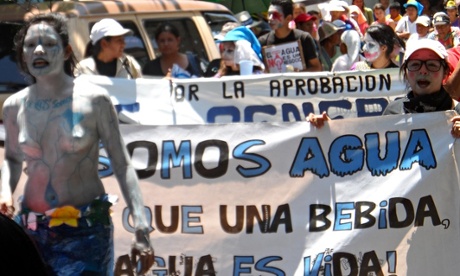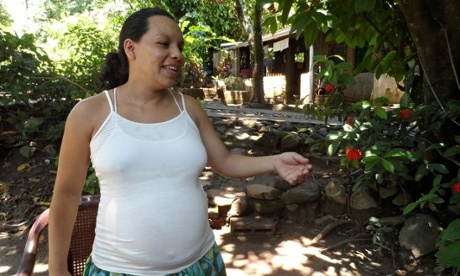
Ana Luisa Najarro’s neighbours include some of the world’s largest corporations. Down the street from her house, giant drinks manufacturers have set up a series of factories and warehouses, bottling water and fizzy drinks for distribution across the country and export across central America.
Coca-Cola is here, bottled by a subsidiary of SABMiller, the world’s second-largest brewer. A Mexican juice multinational has also moved in, as has a large bottled water company.
Millions of dollars are made by major beverage businesses in Nejapa, an expanding industrial area in El Salvador near where Najarro lives. But despite living down the road, and on top of one of the country’s largest aquifers, she says she struggles every day to find enough clean water to drink.
“Nejapa is a gold mine for water. It’s rich in water, and the communities have no access,” says Najarro, sitting in her garden. Her family has lived on this plot for three generations and she remembers a time when water was plentiful. “There were beautiful rivers you could go to and wash or swim. Now we can’t use the water for anything,” she says. “The water in the river is dirty; it’s dead water.”
Just 20km north of the capital, San Salvador, Nejapa is an ecologically critical zone in central America’s smallest and most densely populated country. Salvadoran civil society groups say it is also a prime example of how unfettered competition over limited resources has created scenes of extreme water poverty next door to water-intensive industries.
By most measures, El Salvador is under extreme environmental stress: highly susceptible to natural disasters, it is often cited as the second most deforested state in Latin America after Haiti. With an estimated 90% of its surface water heavily contaminated, it is struggling with a national clean-water crisis.
The aquifer beneath Nejapa is one of the country’s largest and most important, feeding local farms, communities and much of San Salvador. Carlos Flores, an activist with the Foro del Agua (Water Forum), a broad coalition of environmental and social organisations, says companies started moving in 20 years ago. Today, he says, almost a third of households have little or no access to water: “There are dry sources, or polluted sources.”
Companies in Nejapa deny that their presence has made things worse for local communities.
But Iris Arévalo, a doctor in Nejapa, says the distribution of resources in the area is anything but fair.
“It is not possible that these scarce resources don’t go to the people; water is vital to the communities,” she says. “Families need water to live, to survive, for their health. However, the companies need it for mercantilism, to sell and get profit. This is the big difference.”
Najarro speaks in even starker terms.

She compares the companies that have moved into her area to the Spanish conquistadors who invaded America. “I think we are practically reliving the period,” Najarro says. “They come, they exploit, they destroy, and then they leave to find some other place where they can continue the exploitation and destruction. And we have nothing.”
Najarro says she pays $7 a month (£4.38; almost 10% of her salary) for municipal water, even though her taps often run dry and the water that runs from them may not be safe to drink. Purified bottled water, such as that produced by companies in Nejapa, is out of reach for many Salvadorans.
Across the country, a growing water justice movement is now calling for the government to step in and pass new legislation to ensure the human right to water.
In March, thousands of people marched to the legislative assembly in San Salvador, to demand that those inside revive stalled negotiations on a long-debated general water law which would, among other things, establish a hierarchy of use and prioritise water for human consumption over that for industry or commerce.
This summer, the leftwing Farabundo Martí National Liberation Front (FMLN), a long-time supporter of a bill to this effect, reintroduced it in the legislative assembly just months after winning a narrow victory in the 2014 national elections.
“We are the country with the worst water stress in Latin America,” said Ángel Ibarra, the vice-minister for the environment. “We are for this law not for ideological reasons, but to make sure that everyone has access to water and to resolve the conflicts in [various] places.”
But few expect the revived negotiations to go smoothly. The Foro del Agua first introduced proposals for such a law in 2006, and previous attempts to pass it were fiercely opposed by the rightwing party Arena.
In Nejapa, concerns about water scarcity have pitted some local residents against their corporate neighbours.
Recently, protests have targeted a SABMiller subsidiary, Industrias La Constancia (ILC), and its planned expansion in the area. Activists say the project would hand even more water over to the multinational while further threatening the aquifer and long-term local water security.
SABMiller, which sponsors a section of the Guardian’s Global Development Professionals Network, said: “We acknowledge that Nejapa is a water-stressed region, which is why we support the local communities in their struggle to access clean water. Our belief is that access to clean water is a human right, but water use, protection and conservation is a shared responsibility among all water users, including industry. To that end, we are fully supportive of the water law in El Salvador.”
Najarro sees the company’s planned expansion as a threat, however. “We have just spent 15 days without water,” she says. “If they continue to exploit our water in this way, it’s clear that we will not have any left in Nejapa.”
